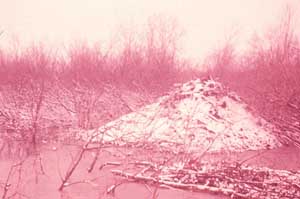|
|
 4 house insulation DHJanzen100877.jpg high resolution
|
|
|
A beaver house in March when the ice has thawed, followed by a snow fall. Note that the snow has not melted, even though just 1-2 feet below it, the temperature is 70-90 degrees F. When a traveling salesman for roofing insulation wants to find a candidate, he drives down northern streets after an evening snowfall, looking for roofs where the snow has melted. This beaver house covered with a solid white layer of new snow emphasizes how good is the insulation offered by a thick layer of frozen mud. Incidentally, if one were to climb to the top of this beaver house (about 2 m tall) and look directly down on the top, there would be a small area where the snow is melted by the hot air rising through a small hole in the top, presumably constructed (or allowed) by the beaver for air exchange. Think of 3-5 large mammals (perhaps a total of as much as 200 pounds) living, sleeping and active in this very closed in room. CO2 levels must climb to very high levels but still there must be a process of steady replenishment of outside oxygenated air through the hot air rising out the roof hole and cold oxygenated air sinking in through other smaller holes in the roof. |
||
back to lecture slides
or skip to: